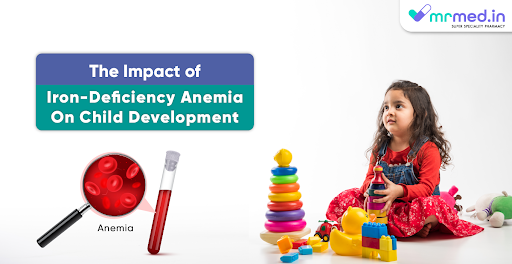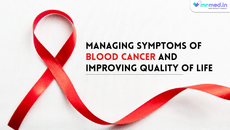Childhood is a key stage of life marked by quickening physical and mental development. Proper diet is essential for supporting healthy growth at this crucial time. Iron-deficiency anemia (IDA) is a common nutritional condition affecting children worldwide. This illness develops when the body cannot create enough hemoglobin, the protein that carries oxygen in red blood cells, due to iron deficiency. Although anemia frequently has physical signs, it also significantly influences a child's cognitive development. In this article, we shall examine how iron deficiency anemia impacts children's cognitive function and development, highlighting the need for early identification and intervention.
The Link between Iron-Deficiency Anemia and Child Development
1. Cognitive Function
The function and growth of the brain depend on iron. Early in childhood, the brain experiences fast development and forms important synaptic connections that serve as the building blocks for later learning and cognitive ability. Neurotransmitters, which are crucial for transmitting information between brain cells, are largely produced by iron. Low iron levels can interfere with neurotransmitter synthesis and activity, which impairs cognitive function.
According to studies, children with iron deficiency anemia may struggle with memory, attention, focus, problem-solving, and language development. These cognitive difficulties may impact learning outcomes and general cognitive capacities into adulthood.
2. Behavioral and Emotional Issues
Beyond cognitive function, iron deficiency anemia has a negative consequence. Behavioral and emotional difficulties in children with IDA might include impatience, restlessness, and a decreased capacity to handle stress. They could also have trouble controlling their emotions, which can cause mood swings and outbursts. These behavioral problems impede a child's capacity to flourish in social situations and strain connections with classmates and family.
3. Physical Development
Iron deficiency anemia can hinder physical development in addition to hurting cognition and emotion. Haemoglobin, the protein that delivers oxygen to the body's muscles and tissues, is made using iron, which is necessary for its creation. Anemia can cause an inadequate oxygen supply, leading to weariness, weakness, and decreased physical stamina. As a result, kids with IDA may experience delayed motor development, disrupting developmental milestones like walking and running.
Early Detection and Intervention
The effects of iron deficiency anemia on a child's cognitive ability and development highlight the value of early identification and care. Pediatricians and other carers should be alert to the following possible symptoms of childhood anemia:
- Fatigue and weakness
- Pale skin and mucous membranes
- Poor appetite
- Shortness of breath
- Frequent infections
- Delayed development and growth
It is critical to seek medical help immediately for a correct diagnosis and course of treatment if any of these symptoms are noticed.
Treatment and Prevention
For the most part, iron supplementation and treating the underlying cause of the shortage are used to treat iron-deficiency anemia in children. There are several iron supplements, such as ferrous sulfate, ferrous fumarate, and ferrous gluconate. A medical specialist should decide on the iron supplement type and the appropriate amount depending on the child's age, weight, and anemia severity.
1. Oral Iron Supplements: Oral iron supplements are an efficient treatment for most mild to moderate instances of iron deficient anemia. Both over-the-counter and prescription versions of these vitamins are readily available. To get the best benefits, the recommended dosage must be routinely administered.
2. Liquid Formulations: Liquid forms of iron supplements are available for younger kids who might have trouble swallowing tablets. These could be easier to take and more appealing, resulting in higher adherence to the treatment regimen.
3. Combination Supplements: To improve iron absorption, certain iron supplements are mixed with other vitamins and minerals, such as vitamin C. This might be especially helpful if the child's diet lacks important components for optimum iron absorption.
4. Intravenous Iron Therapy: Healthcare practitioners might consider intravenous iron treatment in extreme cases of iron-deficiency anemia or when oral supplementation is poorly tolerated. For intravenous therapy, Encicarb Injection, a medicine that is part of the class of medications known as iron replacement medicines, is frequently used. Iron is given straight into the circulation during this treatment, which can quickly raise iron levels.
Prevention is crucial in the fight against iron deficient anemia. Including iron-rich foods in a well-balanced diet can help avoid anemia in children. These foods include lean meats, fish, fortified cereals, beans, and leafy green vegetables. Vitamin C-rich meals, such as citrus fruits and tomatoes, can also improve iron absorption from plant-based sources.
Conclusion
Iron deficiency Anemia is a frequent illness that can significantly affect a child's cognitive development and growth. The deficit has a detrimental impact on a child's cognitive functioning, behavioral habits, and physical development, potentially lowering their potential. Early identification and treatment are crucial to lessen the effects of childhood anemia. We can ensure that kids get the nutrients they need to promote healthy development, cognitive function, and emotional well-being through iron supplementation and dietary modifications. To raise a generation of successful and intellectually capable people, it is essential to provide parents, carers, and medical professionals with information regarding the effects of IDA on child development.
About Author: MrMed Pharmacy is a reputable and trusted pharmacy that aims to provide high-quality super speciality medicines to its customers. With a customer-centric approach, MrMed.in strives to create a positive and supportive environment for individuals seeking pharmaceutical services.




